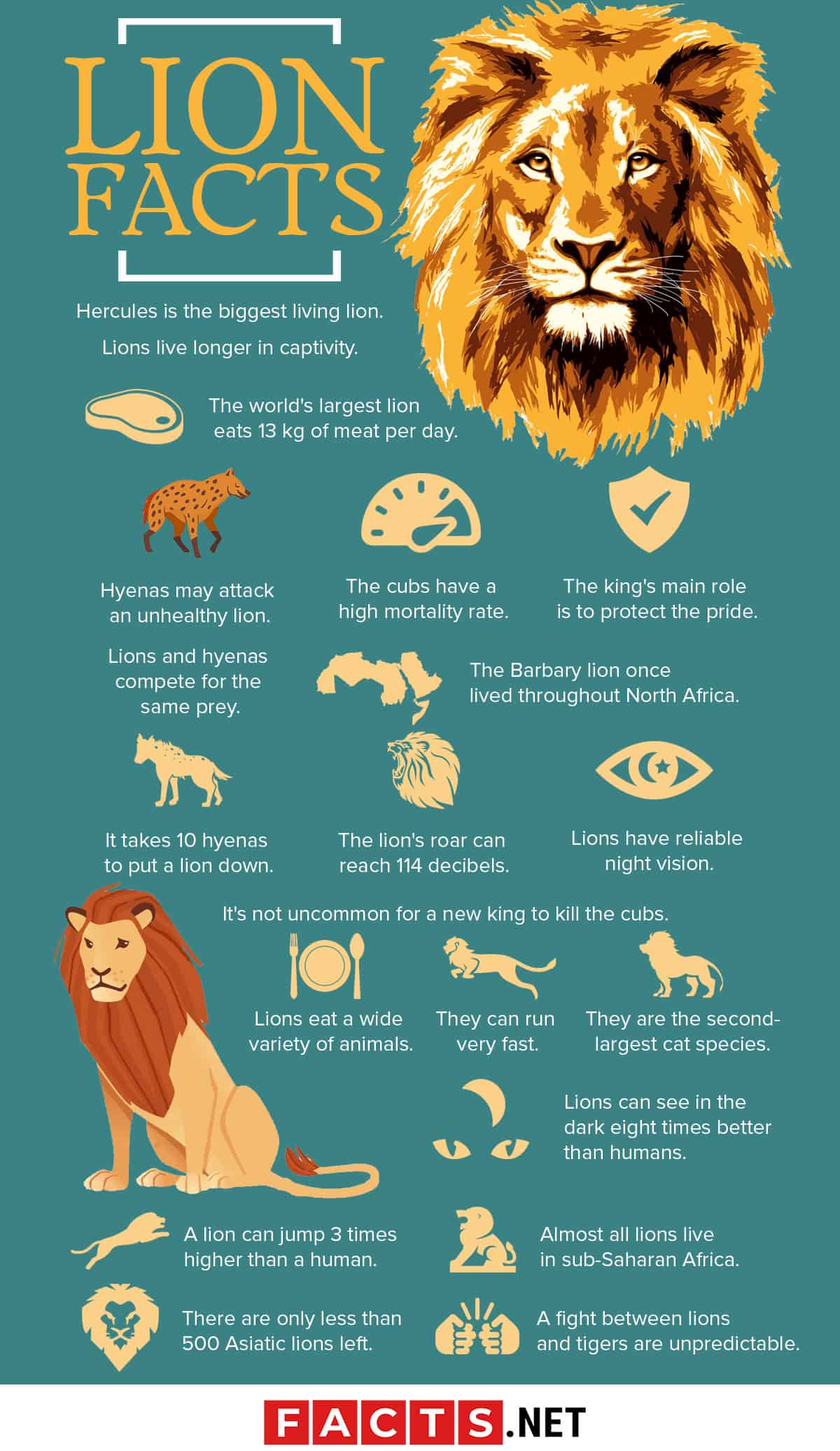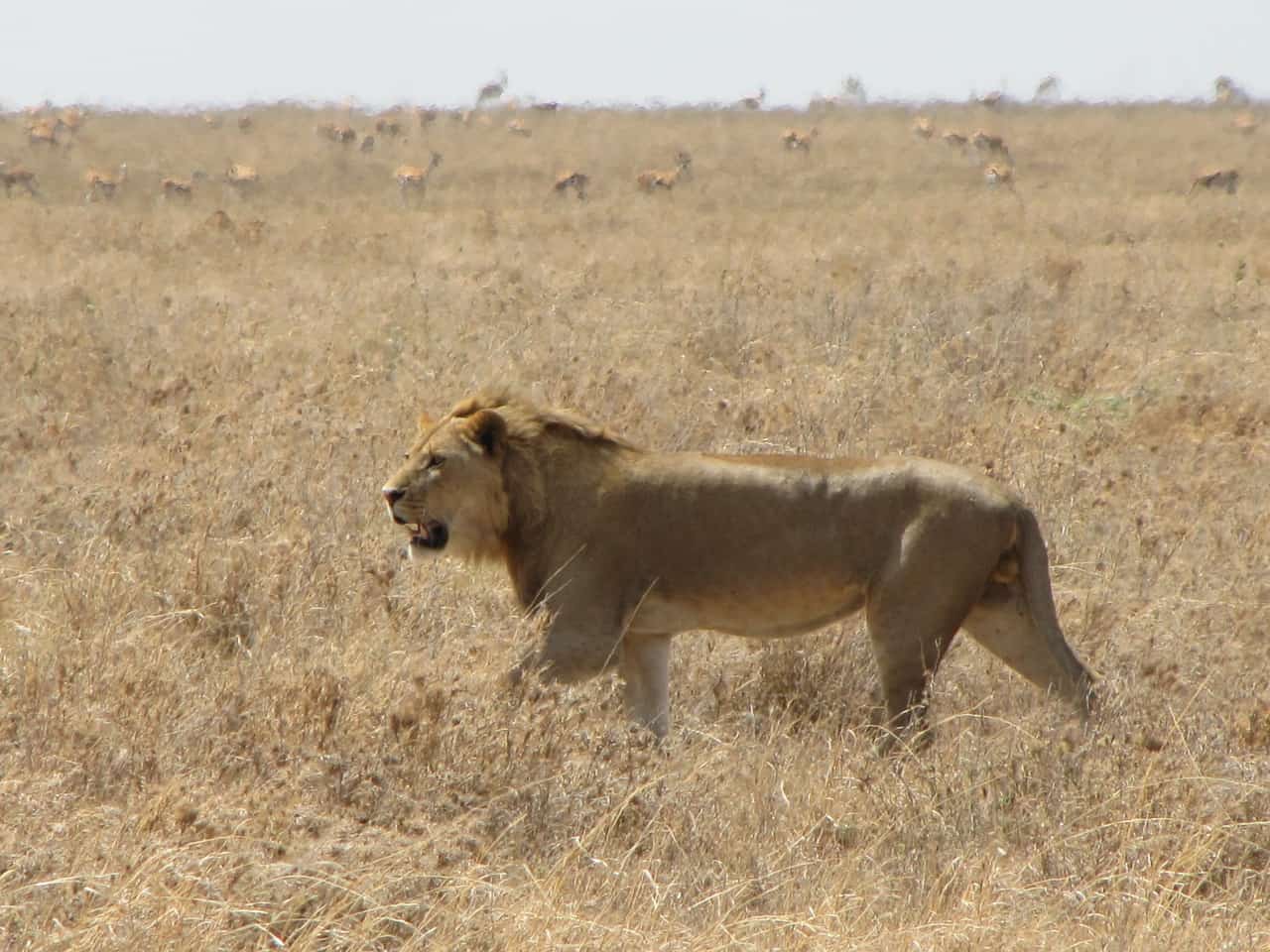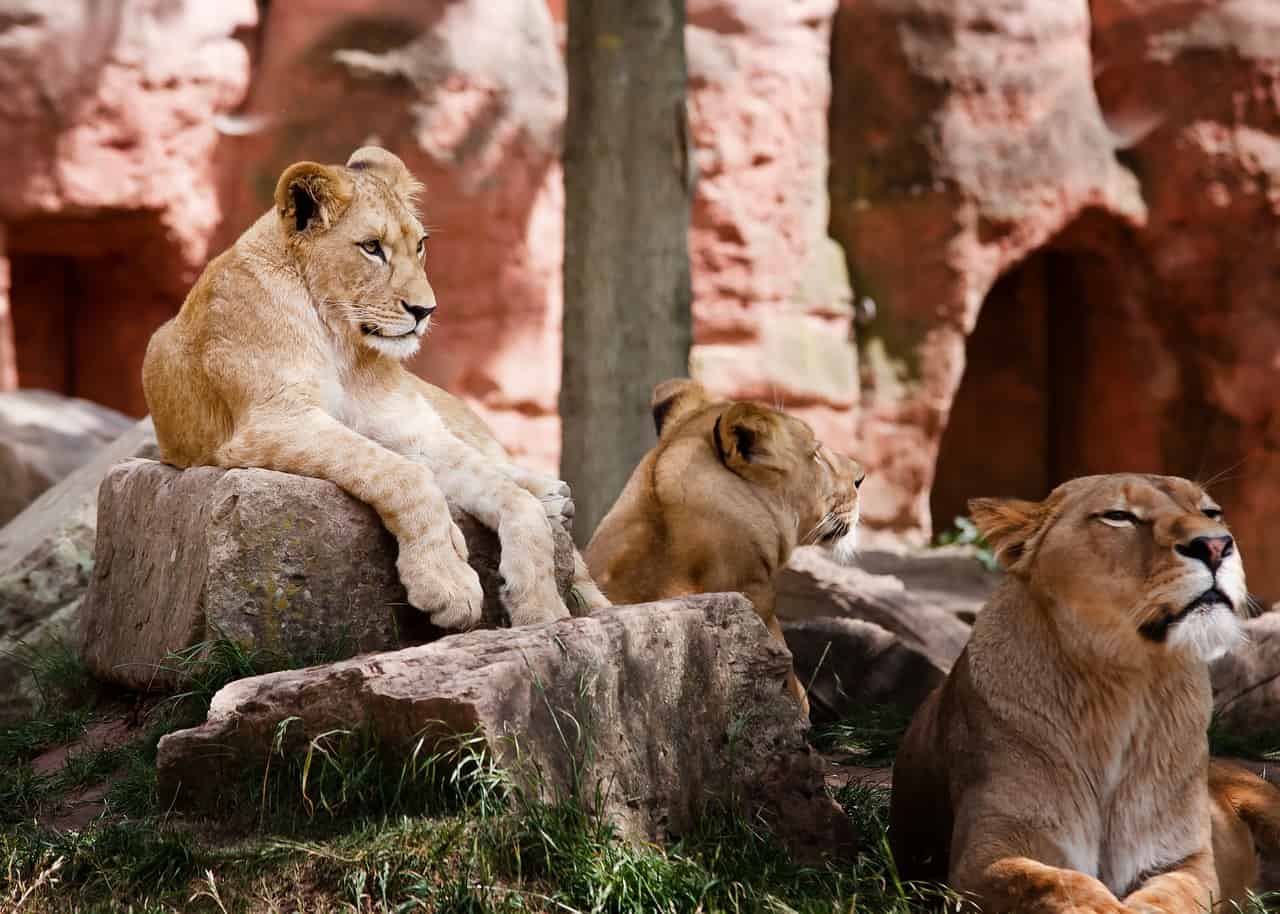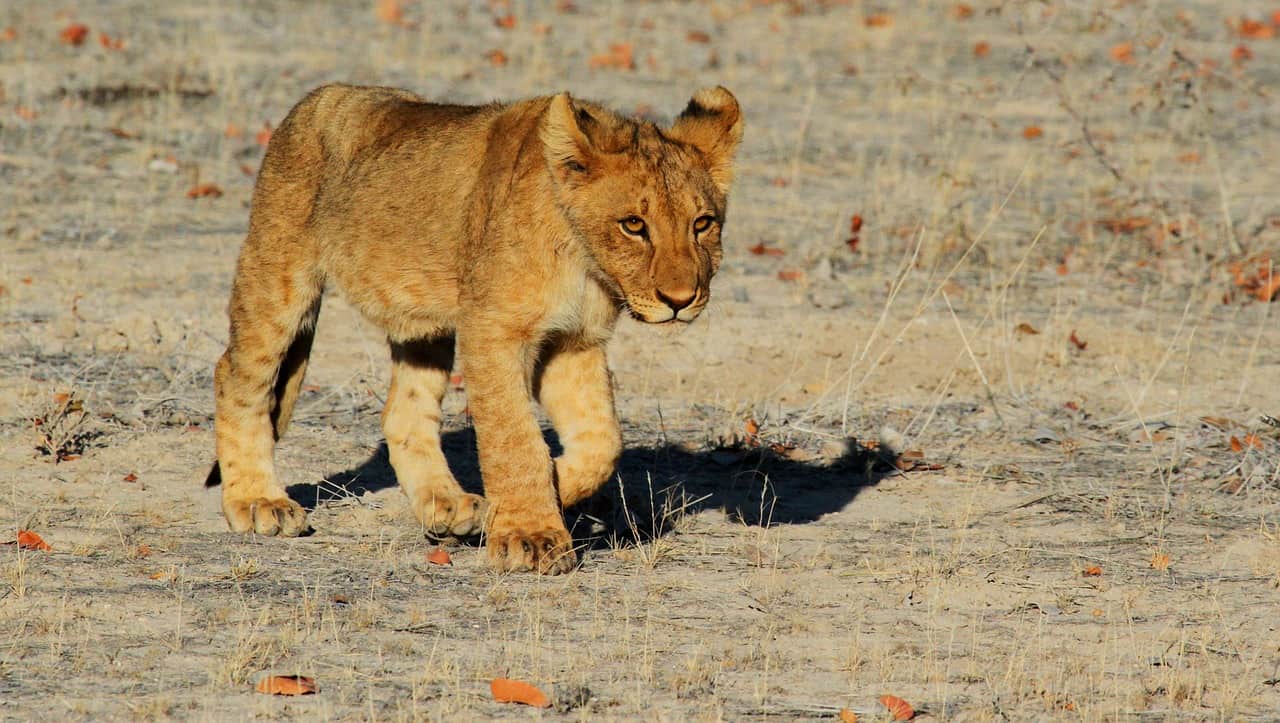
While some may just see them as big cats, lions are the kings of the jungle. Their brute force, power, and agility give these animals their reputation. Lions do not fear any other creature in the wild, regardless of how big or small it is. Get to know more about these feline kings with these lion facts.
- Lions can live up to 10 to 14 years.
- A lion’s roar can be heard from 8 km away.
- Lions in the wild eat more than 40 kg of meat per day, while lionesses eat around 25kg.
- After lions eat their “one big meal” (40kg or more), it can survive for over one week without food.
- Lions can run up to 81 kmph (50 mph) for short bursts.
- The lion belongs to the Felidae family.
- Panthera leo is the scientific name of the lion.
- Lions first evolved 320,000 years ago.
- Lions are relatively “short”, compared to their body size, with a deep-chested body.
- The lion has a rounded head and ears along with a hairy tuft at the tip of its tail.
- A female lion is called “lioness,” while a baby lion is called “cub.”
- The majority of prey hunting is done by the lionesses.
- In contrast to other cat families, lions are very social animals.
- Lions live in groups called prides, of about 30 lion individuals.
- A fully grown adult lion can weigh more than 400 lbs or 190 kg.
- The largest lion ever recorded grew up to 11 feet long.
- An adult lioness weighs around 286 lbs or 130 kg.
- A pride only has up to 3 males with several females and their young.
- Even though they’re called king of the jungle, they don’t live in the jungle. They live in savannas and grasslands.
- Lions love to sleep at least 20 hours a day.
Lion Facts Infographics

Hercules is the biggest living lion.
The Guinness World Records ranks Hercules from the US as the biggest surviving lion. Measuring 3.33 m or 10 ft long and standing 1.25 m or 4 ft and 10 in tall, Hercules towers over any other living lion. With a weight of over 900 lbs, Hercules is also the heaviest lion ever recorded.
The world's largest lion eats 13 kg of meat per day.
The biggest living lion eats approximately 13.6 kg of meat a day, which is equivalent to the size of a toddler. Hercules has one brother named “Sinbad” and has four nephews named “Sampson,” “Odin,” “Yeti,” and “Apollo.”
The Barbary lion once lived throughout North Africa.
Now extinct, the Barbary lion once lived throughout North Africa. According to the accounts of hunters from the 19th century, the Barbary lion may have been the biggest lion species to ever exist.
Ranging from 600 to 660 lbs, Barbary lions dwarfed the modern lion’s average weight of 400 lbs. However, there is no evidence to back up the claims of the hunters from the 19th century.

Lions live longer in captivity.
The lifespan of lions in the wild ranges from 10 to 14 years. However, being kept in captivity can double or even triple their lifespan. Captive lions may reach up to 30 years of age due to the abundance of food and nutrition.
Hyenas may attack an unhealthy lion.
Even though lions stand on the top of the food chain, there are still some cases where they can be the prey. An old, sick, or injured lion can be attacked and killed by healthy hyenas in their prime. Definitely one for unfortunate lion facts.
Lions and hyenas compete for the same prey.
Both of them are known to wander in the same field, hunt the same prey, and scavenge for the same animal remains. Even more, these two species may even steal a meal from each other.
It takes 10 hyenas to put a lion down.
A desperate group of hungry hyenas may attack a lion if it’s alone. Normally, it would take 10 hyenas to tear down a single healthy lion at its prime, but even with those numbers, it’s not a guarantee.
Even a single lion can scare and fight off an entire clan of hyenas. For the lioness, it would take 5 to 6 hyenas to take her down.
The cubs have a high mortality rate.
Defenseless lion cubs have a high mortality rate of 60 to 70%. This leaves them vulnerable to other predators such as leopards, black-backed jackals, and of course, hyenas.
The king's main role is to protect the pride.
One of the cooler lion facts is that the Lion King isn’t just a Disney film. In an actual lion pride, the king holds the responsibility of protecting the lionesses and their cubs. The king shares this responsibility with other males in the pride which usually ranges from 3 to 4 males.
The lion's roar can reach 114 decibels.
Lions usually roar very loud after sunset. A lion”voice” can reach a level of 114 decibels, which is almost double the amount of the safe hearing level for humans. Generally speaking, any sound above 85 dBA would damage a human’s hearing ability over time.
It's not uncommon for a new king to kill the cubs.
It has been a custom for a new king in the lion’s pride to kill all the cubs left by the old king. By doing so, it guarantees him that the future members will have his genes. Definitely one of the darker lion facts.
Lions eat a wide variety of animals.
The lion’s diet includes ranges throughout the savanna, from buffaloes, crocodiles, to young elephants. If needed, lions may also hunt small creatures such as mice, lizards, tortoises, and birds. Overall, this makes lions an essential predator in an area’s ecology.
Lions have reliable night vision.
Lions have fewer cones in their eyes, which makes them see less color. However, this structure also provides them with strong night vision. A lion’s eyes have a membrane called the tapetum lucidum which focuses weak light back to the retina.
Because of this feature, a lion’s pupils can enlarge around 3 times bigger than the human’s pupil.
Lions can see in the dark eight times better than humans.
The lion’s eyesight is one of its most important senses. Although it’s not as good as the human’s eyes during the day, they can see up to 8 times better at night. However, this does not mean that lions can see in a pitch-black environment.
Instead, they take advantage of the minimal light shone by stars and the moon.
They can run very fast.
In short bursts, lions can run as fast as 80 kmph. This speed rivals horses that can run for about 88 kmph, or as fast as an average car on a highway. However, lions can’t sustain this speed for too long, as they have less stamina.
A lion can jump 3 times higher than a human.
Although lions weigh approximately 2.5 times heavier than an average human, they can jump 3 times higher than us. Moreover, tigers and lions almost have the same vertical leap which can reach more than 11 to 12 feet.
They are the second-largest cat species.
After tigers, lions are the second biggest cat species. As mentioned above, lions can grow just nearly four feet in height while tigers can grow as much as five feet and five inches.

A fight between lions and tigers would be unpredictable.
According to experts, a fight between a lion and tiger would be almost impossible to predict. While tigers are bigger and heavier, lions have better fighting skills. All in all, it’s a 50-50 chance for either species.
Almost all lions live in sub-Saharan Africa.
Although the Gir National Park of India houses Asiatic lions, almost all lions in the world reside in sub-Saharan Africa.
There are only less than 500 Asiatic lions left.
The International Union for Conservation of Nature (IUCN) Red List of Threatened Species classifies India’s Asiatic lions as an endangered species. Currently, the population of Asiatic lions has less than 500 individuals. Now there’s one for alarming lion facts.
The Asiatic lion has a distinct appearance.
The Asiatic lion’s coat ranges from ruddy-tawny, heavily speckled, with buffish grey, black, or sandy, and even includes silvery sheen certain spots. Moreover, the male Asiatic lion’s ears stay visible, with only a modest fur growth at the top of its head.

Lions are a vulnerable species.
Even if the lions didn’t make the IUCN’s red list of endangered species, they are classified as vulnerable. With only around 20,000 lions left in the world, lions have been extinct in 26 African countries. Throughout history, the lion population has decreased by around 95% already.
Several countries have declared the lion as their national animal.
Lions are the national animals of many countries such as Luxembourg, England, Belgium, Albania, Ethiopia, Netherlands, and Singapore.
Lions can breed with other cats.
On rare occasions, lions can crossbreed with other cat species such as leopards, jaguars, and tigers. When leopards and lions breed, its offspring is called leopons, while jaguar crosses rear “jaglions,” and tigers crosses produce “ligers.”
The leopon resembles a lion more than a leopard.
The leopon’s face mostly resembles a lion, but its body more closely represents the leopard’s. These types of crosses are displayed in captivity and rarely happen in the wild.
Jaglions take after jaguars more than lions.
Jaglions only share a lion’s color, but the rest of its features largely resemble a jaguar’s. Generally, its physical appearance is dominated by the jaguar’s form and inherits its dark-colored patches in the skin.
The ligers are bred for a profit.
Of all lion crossbreeds, ligers are the most even mix. Ligers have light brown coats reminiscent of a lion with the stripes of a tiger. Because of this perfect mix, ligers tend to be the most expensive, usually bred for business or profit.
Male lions sleep longer than females.
Male lions sleep around twenty hours per day, while lionesses in general sleep 15 to 18 hours per day. Thus, lionesses do all the “hard work” of hunting for its pride as well as taking care of its cubs.
Lions don't like dense forests.
Contrary to their title of being the King of the Jungle, lions actually stay away from dense forests with thick canopies. Instead, they prefer the open grasslands of the savannas.
Ancient Egypt used to hunt lions.
Lion hunting has been a common event from ancient times. In ancient Egypt, warriors would hunt lions for the pharaohs. As a result, the lion population in North Africa nearly faced extinction by 1,100 BC.
Lions have three types of teeth.
Like humans, lions have different kinds of teeth for different functions. A lion’s powerful jaws come lined with incisors, canines, and carnassials or the sharpest teeth at the back of the lion’s mouth.
Lion teeth serve different functions.
A lion’s incisors are for gripping and tearing meat, while its canines serve as the “main weapons” for its prey. Meanwhile, a lion’s carnassial teeth function like “scissors” that gnash and cut at meat.
A lion's paws share many similarities with a cat's paws.
The paws of lions are extremely similar to a regular cat, though way bigger in size. Lions have five toes on its front paws and four on the back. Measurements taken from a lion’s paw print can also help experts estimate how old a lion is, as well as its gender.
Lion cubs are born grey.
Upon birth, lions have greyish fur with dark spots covering most of its body.
A lion's mane starts to grow one year after birth.
When males reach 1 year old, their hair starts to grow longer around their necks and chests. This stage establishes the beginning of their mane, the fur around the face, which will grow even more once they reach two years old.
Lionesses don't have manes.
A lion’s full mane normally grows long, extending across their belly. Sometimes it even grows to their front legs and elbows. However, the lionesses don’t grow manes.

No one can say why lions grow a mane.
Although no one can say why lions grow a mane, some researchers believe that it protects the lion’s neck while fighting. It also allows them to look bigger, thus intimidating other animals.
Healthy lions have black manes.
Having a thick, dark mane indicates that a lion is well fed. It is likely that a dark-maned lion also has more testosterone and receives more attention from females. Typically, a dark mane also signifies that the lion is at its prime.
A lion's tongue is full of tiny spikes.
Like other felines, a lion’s tongue is lined with papillae, which gives it the texture of rough sandpaper. These papillae are tiny, sharp, backwards-facing spikes along its tongue. It helps the lion groom as it removes dirt more easily from their fur. It also helps them scrape meat from bones during meals.
Lion whiskers are specialized hairs that aid navigation.
All cat species have whiskers, and lions are not exempted. The lion’s whiskers are extremely sensitive organs, guiding them to feel, measure, or estimate stimuli around them.
The lions' black spots at the root of their whiskers are unique for each lion.
All lions’ whiskers have a black spot at their root. Like human fingerprints, the pattern of each spot are unique for every lion. Through these distinct marks, lion experts can tell them apart in the wild.
Lions can communicate through their tails.
Lions have long tails that can reach up to one meter in length. They may use their tail anytime to lead or guide the pride through long grass. Lioness raises their tail as a sign of “let’s go this way” for their cubs, as well as a communication tool when hunting prey.
You can tell if a lion is in a bad mood by observing its tail.
The lion’s tail also serves as a very good indicator of how they are feeling. When lions flick their tails, it can warn the pride to give them a little space because they are not in a great mood.
Cubs are born blind.
Cubs usually start to open their eyes about three to four days old. Initially, its eyes have a blue-grey color, eventually fading into an orange-brown shade by the age of two to three months.

Lions have scent glands in certain parts of their body.
Lions have scent glands around their cheeks, lips, whiskers, chins, in between their toes, and tails. These glands excrete an oily substance that keeps their fur healthy. Much like humans, we have glands that keep our hair greasy, showing up when we haven’t used shampoo for quite some time.
Their sense of smell is strong.
Lions identify their territories using scent deposits, which require a good sense of smell. This sense also helps lions find kills from other predators. In general, all felines have an exceptional olfactory organ on the roof of their mouth known as the Jacobson’s organ.
Lions also have an excellent sense of hearing.
Lions can maneuver their ears in various directions to listen to sounds in their environment. Their sense of hearing can reach over a mile away, which provides them another edge when catching prey.
Lions are hunted not just for meat but for most of its body parts.
According to the people who have tasted lion meat before, lions taste like pork but with a stronger flavor. From ancient times to this day, lions are still hunted by humans for their teeth, claws, fur, bones, and other parts.
White lions are critically endangered.
You can find the rare color mutation of the white lion in Timbavati National Park in South Africa. It was thought to be endemic to the place for many centuries. Fortunately, this rare color mutation has not affected the white lion’s survival in the wild. However, they are critically endangered and not protected well.
Was this page helpful?
Our commitment to delivering trustworthy and engaging content is at the heart of what we do. Each fact on our site is contributed by real users like you, bringing a wealth of diverse insights and information. To ensure the highest standards of accuracy and reliability, our dedicated editors meticulously review each submission. This process guarantees that the facts we share are not only fascinating but also credible. Trust in our commitment to quality and authenticity as you explore and learn with us.
